There are many pathways to a world free of nuclear weapons. … Our focus must be on taking steps in eliminating nuclear weapons and doing so in good faith.
The year 2019 witnessed a continuation—and, in some cases, a worsening—of negative trends that had plagued nuclear disarmament efforts in previous years: deteriorating geostrategic conditions, growing distrust and acrimony among nuclear-armed States, and widening fissures between Member States over how to achieve the common goal of eliminating all nuclear weapons. Together, those developments placed growing pressure on the web of agreements and instruments that make up the disarmament and non-proliferation regime, undermining existing efforts and imposing new obstacles to progress. As the Secretary-General stated at the Conference on Disarmament in February, “Key components of the international arms control architecture are collapsing.”
The third session of the Preparatory Committee for the 2020 Review Conference of the Parties to the Treaty on the Non-Proliferation of Nuclear Weapons (Nuclear Non-Proliferation Treaty)—considered by most States to be the cornerstone of the disarmament and non-proliferation regime—saw heated debates and the exposure of significant divisions between States parties over commitments made under the Treaty, particularly with regard to their enduring relevance and issues of compliance. Divisions were noted among nuclear-weapon States, between nuclear-weapon and non-nuclear-weapon States, and between groups of non-nuclear-weapon States. Although States parties reiterated their commitment to the Treaty and its goals, their discussions reflected the challenge they faced in seeking a successful outcome at the 2020 Review Conference.
Relations between States possessing nuclear weapons worsened significantly during 2019, with dire consequences for the disarmament and non-proliferation regime. In August, the United States of America announced its withdrawal from the Treaty between the United States of America and the Union of Soviet Socialist Republics on the Elimination of Their Intermediate-Range and Shorter-Range Missiles (Intermediate-Range Nuclear Forces Treaty) of 1987 due to continued violations by the Russian Federation. As the first agreement on eliminating an entire category of nuclear-capable weapons, the Treaty was widely seen as a pillar of the international arms-control regime, and its demise represented a significant blow to that architecture. Its collapse also placed in doubt the future of the Treaty between the United States of America and the Russian Federation on Measures for the Further Reduction and Limitation of Strategic Offensive Arms (New START Treaty) of 2011, which, despite repeated calls from the international community— including the Secretary-General—would expire in 2021 if not extended,.

For over 50 years, but especially since the end of the cold war, the United States and the Russian Federation (formerly the Soviet Union) have engaged in a series of bilateral arms control measures that have drastically reduced their strategic nuclear arsenals from a peak of around 60,000. The most recent of those measures, the New START Treaty, limits the number of deployed strategic nuclear weapons to 1,550 per State. New START is scheduled to expire on 5 February 2021; should it expire without a successor or not be extended, it will be the first time that the strategic arsenals of the United States and the Russian Federation have not been constrained since the 1970s.*
* The New START Treaty entered into effect on 5 February 2011 for a period of 10 years. It can be extended for up to five years, unless it is replaced earlier by another agreement.
Source: Federation of American Scientists
Acronyms: SALT I=Strategic Arms Limitation Treaty; INF=Intermediate-Range Nuclear Forces Treaty; START=Strategic Arms Reduction Treaty; SORT=Strategic Offensive Reductions Treaty; New START=Treaty on Measures for the Further Reduction and Limitation of Strategic Offensive Arms.
In parallel, all States possessing nuclear weapons continued to modernize their nuclear arsenals, including through the testing and deployment of new weapon systems. In December, the Ministry of Defence of the Russian Federation announced it had fit intercontinental ballistic missiles with a new hypersonic glide vehicle, consistent with a 2018 announcement by the President of the Russian Federation, Vladimir Putin. Similarly, the Russian Federation continued testing a new silo-based intercontinental ballistic missile. Meanwhile, following its withdrawal from the Intermediate-Range Nuclear Forces Treaty, the United States conducted two series of tests with missiles that would have been prohibited under the Treaty.

Opening ceremony of the “Comprehensive Nuclear-TestBan Treaty: Science and Technology 2019 Conference”, Hofburg Palace, Vienna, Austria, 24 June 2019.
Photo credit: Preparatory Commission for the Comprehensive NuclearTest-Ban Treaty Organization
Regional crises with nuclear dimensions also worsened in 2019. In May, responding to the United States’ withdrawal from the Joint Comprehensive Plan of Action and reimposition of related unilateral sanctions, the Islamic Republic of Iran said that it would scale back its nuclear commitments under the agreement in 60-day increments in the absence of meaningful sanctions relief.
Separately, the Democratic People’s Republic of Korea and the United States achieved no substantial progress towards the complete and verifiable denuclearization of the Korean Peninsula, including through implementing the Joint Statement from their 2018 summit in Singapore. Inter-Korean relations also continued to deteriorate following the signing of the Panmunjom Declaration of April 2018, with the Democratic People’s Republic of Korea refusing to engage in dialogue with the Republic of Korea. Throughout the year, the Democratic People’s Republic of Korea appeared to continue the development of its nuclear and missile capabilities, including by launching over 20 short-range ballistic missiles and large-calibre artillery rockets on 13 separate occasions. With the expiration of a year-end deadline set by the Democratic People’s Republic of Korea for the United States to propose “new calculations” to advance the stalled talks, 2019 ended with uncertain prospects for future dialogue.
Against that background, however, there were several positive developments. “Disarmament to Save Humanity”—the pillar of the Secretary-General’s Agenda for Disarmament dedicated to eliminating all nuclear weapons and other weapons of mass destruction—gained new State “champions” and “supporters” in 2019, with totals of 15 and 14, respectively, as at the end of the year. Furthermore, several cross-regional initiatives were launched in 2019 to support a successful Nuclear Non-Proliferation Treaty Review Conference in 2020.
Many Member States also signalled their commitment to the complete elimination of nuclear weapons through support to the Treaty on the Prohibition of Nuclear Weapons, which at the end of 2019 had 80 signatories and 34 ratifications or accessions. Nevertheless, the Treaty remained divisive, with States possessing nuclear weapons asserting that it undermined existing efforts.
Also in 2019, a Group of Governmental Experts established to consider the role of verification in advancing nuclear disarmament delivered its final report to the General Assembly, identifying possible points of convergence and suggesting a list of principles on verification in advancing nuclear disarmament.
In August, representatives from the five nuclear-weapon-free zones and Mongolia met in Nur-Sultan, Kazakhstan, for a seminar on fostering cooperation and enhancing consultation mechanisms among the existing nuclear-weapon-free zones. Participants discussed ways to improve coordination and achieve more robust cooperation among the zones, strengthen disarmament initiatives and the nuclear non-proliferation regime, and provide impetus to the development of new zones.
The first session of the Conference on the Establishment of a Middle East Zone Free of Nuclear Weapons and Other Weapons of Mass Destruction was held in November, pursuant to General Assembly decision 73/546 of 22 December 2018. The strong commitment of the participating States and their constructive approach resulted in a successful session. By adopting a political declaration, the participating States conveyed a clear message to the wider international community about their renewed commitment to working towards achieving the establishment of the Middle East zone, while keeping the door of the process open to participation by all States from the region.
Photo credit: mwmosser (CC BY-NC-SA 2.0)